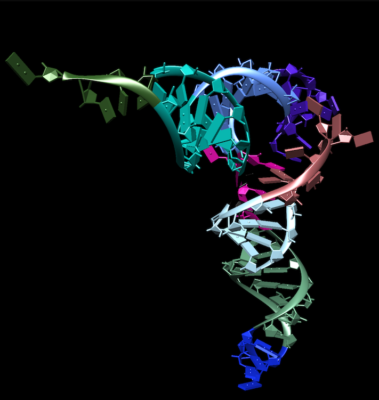 Faced with the failure of the Stanley-Urey model to explain the origin of life, evolutionary scientists have been exploring the RNA World theory. With only the four nucleic acids required to form RNA (pictured left) rather than the twenty amino acids to form a protein, the chance probability tipped the advantage to the RNA-first theory, but that is not all.
Faced with the failure of the Stanley-Urey model to explain the origin of life, evolutionary scientists have been exploring the RNA World theory. With only the four nucleic acids required to form RNA (pictured left) rather than the twenty amino acids to form a protein, the chance probability tipped the advantage to the RNA-first theory, but that is not all.
In The Ancestor’s Tale: A Pilgrimage to the Dawn of Evolution, Richard Dawkins explains –
“This is the RNA World. To see how plausible it is, we need to look at why proteins are good at being enzymes but bad at being replicators; at why DNA is good at replicating but bad at being an enzyme; and finally why RNA might just be good enough at both roles to break out of the Catch-22.”
The RNA World theory solved the chicken-or-the-egg Catch-22 conundrum. At least that was the hope. Notice Dawkins’s use of the word “plausible.” Building proteins requires the information from DNA, but the information in DNA requires enzymes that are proteins—the Catch-22.
Catch-22
The Catch-22 conundrum dogged the origin of life research for decades. Like DNA, RNA contains genetic information. The discovery that certain RNA molecules also have enzyme activity to self-replicate paved the way for solving the Catch-22 puzzle. RNA acts as a protein at times, and at times like DNA.
The RNA World theory has emerged as the most popular natural mechanism for the origin of life. The National Science Foundation (NSF) now actively promotes the RNA World theory. NSF is a United States government agency; its medical counterpart is the National Institutes of Health.
In association with Harvard University, the NSF RNA World theory initiative now exists for “Synthesizing Darwinian Chemical Systems.” Under the direction of Jack Szostak from the Center for Computational & Integrative Biology, Gerald Joyce from the Scripps Research Institute, and Steven Benner from the Foundation for Applied Molecular Evolution, said –
“As both a storehouse of genetic information and a catalyst of metabolic reactions, RNA may have been the critical component that enabled the evolution of life.”
RNA World Beginnings
The RNA World concept started in 1959 when Spanish Catalan biochemist Joan Oró synthesized adenine, a key component of RNA and DNA, from hydrogen cyanide, similar to a Miller–Urey experiment at high temperatures.
By the late twentieth century, origin-of-life researchers began to examine the RNA World theory. American physicist, biochemist, and molecular biology pioneer Walter Gilbert, in 1986, was the first to coin the term “RNA World.”
Gilbert envisioned an RNA-first model on primordial Earth. By the actions of natural selection on RNA, DNA, and protein molecules theoretically formed, with the DNA molecule evolving into an information role, the protein molecules evolving into a catalytic role.
Like the Miller–Urey experiment though, the lack of geological evidence for hydrogen cyanide in the fossil record emerged as a telltale sign. Even worse, hydrogen cyanide is a gas toxic to cellular metabolism. During the German Nazi regime, hydrogen cyanide was the Auschwitz gas of choice.
RNA Critics
To date, not one laboratory experiment with realistic early Earth elements and conditions has produced a single nucleic acid. In 1981, Francis Crick published Life Itself, a book critical of the RNA World theory. “It may turn out that we will eventually be able to see how this RNA world got started,” Crick later wrote in 1993.
“At present, the gap from the primal ‘soup’ to the first RNA system capable of natural selection looks forbiddingly wide.”
Scripps Research Institute biochemist Gerald Joyce states that the “most reasonable interpretation is that life did not start with RNA.” The origin of life is so difficult a problem that German researcher Klaus Dose stated in 1988 that the RNA theory is “a scheme of ignorance. Without fundamentally new insights in evolutionary processes … this ignorance is likely to persist.”
Origin of life scientist Robert Shapiro from New York University, an RNA World critic, notes –
“no nucleotides of any kind have been reported as products of spark-discharge experiments or in the studies of meteorites.”
Stanley Miller, who performed the original Miller-Urey prebiotic simulation test, points out problems with Oro’s simulation – “a high-temperature origin of life involving these compounds [the RNA bases] therefore is unlikely.” The presumption of “bases, adenine, cytosine, guanine, and uracil was readily available on the early earth,” Miller continues, is “not supported by existing knowledge of the basic chemistry of these substances.”
At the Salk Institute for Biological Studies, Leslie Orgel in 1994 noted – “Because synthesizing nucleotides and achieving replication of RNA under plausible prebiotic conditions have proved so challenging, chemists are increasingly considering the possibility that RNA was not the first self-replicating molecule…”.
NASA lost enthusiasm for the RNA world, as well. In the Final Report issued after the “Astrobiology Workshop” in 1996 at Ames Research Center, California, it was concluded –
“It has been postulated that there was a time in protobiological evolution when RNA played a dual role as both genetic material and a catalytic molecule (“the RNA world”). However, this appealing concept encounters significant difficulties. RNA is chemically fragile and difficult to synthesize abiotically. The known range of its catalytic activities is rather narrow, and the origin of an RNA synthetic apparatus is unclear.”
“It goes without saying that the emergence of this RNA world and the transition to a DNA world imply an impressive number of stages, each more improbable than the previous one,” noted the eminent François Jacob in 1997.
In 1998, Leslie Orgel, senior research fellow and research professor at the Salk Institute for Biological Studies, where he directed the Chemical Evolution Laboratory, acknowledged that “we are very far from knowing whodunit” or what were the early environmental conditions on the Earth – intensifying the Darwin Dilemma.
After 150 years running, how life spontaneously began, to which Darwin alluded in the Origin of Species, remains a mystery. The deputy editor of the journal Nature, and science writer, Nicholas Wade, reported in the New York Times in June 2000,
“Everything about the origin of life on the Earth is a mystery, and it seems the more that is known, the more acute the puzzle gets.”
Nearly twenty years later, after Gilbert introduced the RNA World theory, the role of RNA in the origin of life remains elusive, if not improbable. In 2007, commenting in Proceedings of the National Academy of Sciences of the United States of America on a paper by Phillip Baaske, Eugene V. Koonin, Senior investigator at the National Center for Biotechnology Information, National Library of Medicine, and National Institutes of Health, noted –
“[RNA World] still is a hypothetical entity… the evolutionary path to the translation systems remains essentially uncharted.”
Genesis
 A natural explanation for the origin of life still remains beyond the reach of science. John Woodward, an English naturalist, and geologist founded the Woodwardian Professorship of Geology at Cambridge University. Woodward was a close friend of Isaac Newton. In the words of Woodman during the Scientific Revolution –
A natural explanation for the origin of life still remains beyond the reach of science. John Woodward, an English naturalist, and geologist founded the Woodwardian Professorship of Geology at Cambridge University. Woodward was a close friend of Isaac Newton. In the words of Woodman during the Scientific Revolution –
The evidence “Vindicates, supports and maintains the Mosaick Account [Genesis] of things, as exactly agreeable to the Phaenomena of Nature.”
Evidence from molecular biology underscores why the theory of evolution remains speculative but not scientifically valid.
RNA World is a Molecular Biology article.
Darwin Then and Now is an educational resource on the intersection of evolution and science, highlighting the ongoing challenges to the theory of evolution.
Move On
Explore how to understand twenty-first-century concepts of evolution further using the following links –
-
- The Understanding Evolution category showcases how varying historical study approaches to evolution have led to varying conclusions. Subcategories include –
- Studying Evolution explains how key evolution terms and concepts have changed since the 1958 publication of The Origin of Species.
- What is Science explains Charles Darwin’s approach to science and how modern science approaches can be applied for different investigative purposes.
- Evolution and Science feature study articles on how scientific evidence influences the current understanding of evolution.
- Theory and Consensus feature articles on the historical timelines of the theory and Natural Selection.
- The Biography of Charles Darwin category showcases relevant aspects of his life.
- The Glossary defines terms used in studying the theory of biological evolution.
- The Understanding Evolution category showcases how varying historical study approaches to evolution have led to varying conclusions. Subcategories include –


